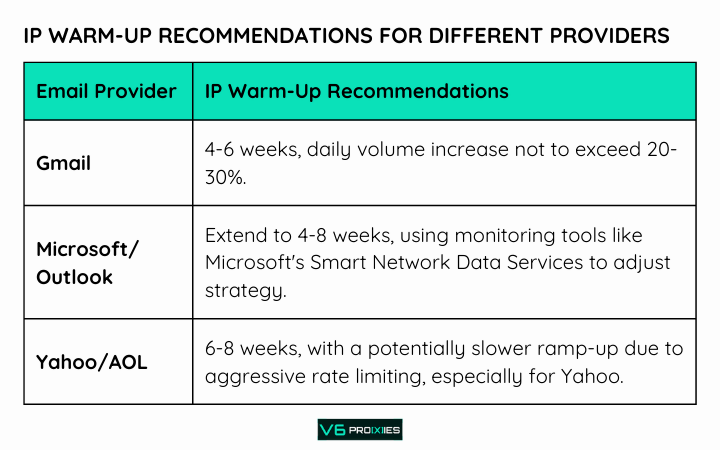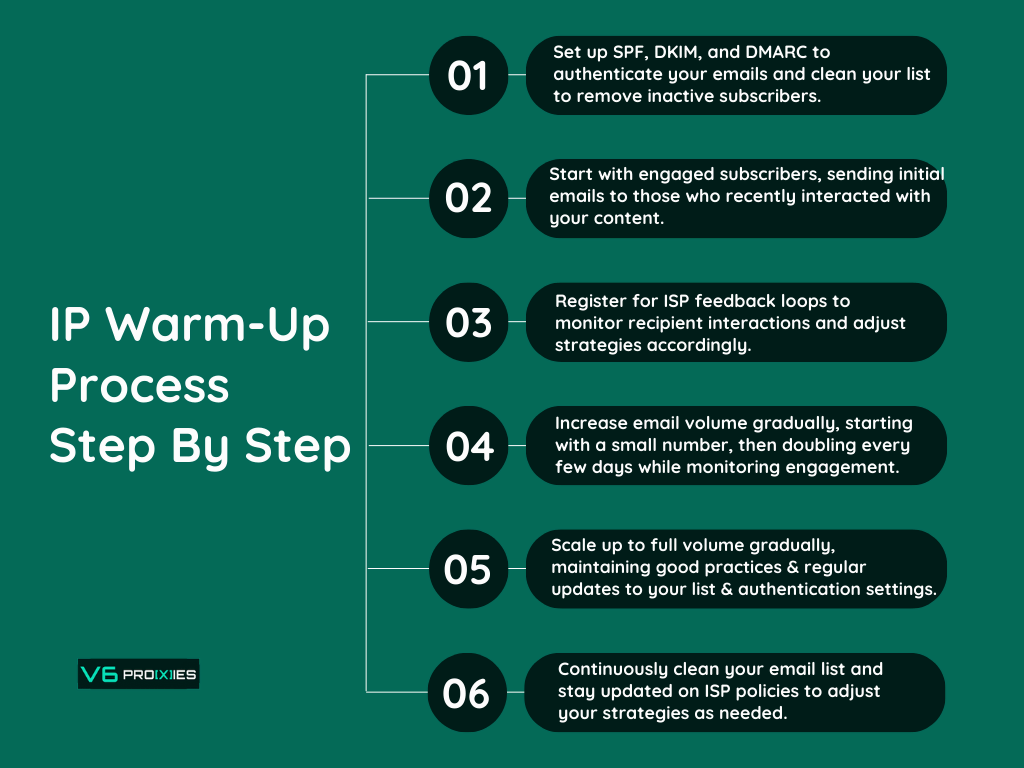For any email sender, having your messages land in the spam folder is the nightmare scenario. All that effort put into crafting the perfect email campaign goes to waste if your emails never reach the intended inboxes. This is where email warmup and IP warm-up play a crucial role. By gradually warming up your IP address and building a positive reputation with email providers, you can significantly improve your deliverability rates and ensure your emails avoid the spam trap.
If you skip the warmup process, the consequences can be severe. Email providers may flag your IP address as a potential source of email spam, leading to widespread blocks or routing your messages straight to the spam abyss. This could spell disaster for your email marketing efforts, damaging your sender reputation and making it extremely difficult to reach your audience’s inboxes.
In Previous guides, we covered Gmail proxies, SMTP proxies, creating SMTP proxies with Python. Today is another mailing excellence guide you need,
Table of Contents
What Is IP Warm-Up?
IP warm-up, also known as IP warming or email warming, is the process of slowly increasing the volume of emails sent from a specific IP address or group of IP addresses. The goal is to establish a positive sending reputation with email providers and internet service providers (ISPs) by demonstrating consistent, legitimate email behavior over time.
Email providers closely monitor the sending history and reputation of IP addresses to identify potential spam sources. If an IP address suddenly starts blasting out a high volume of emails after being inactive or sending low volumes, it raises red flags and increases the likelihood of those emails being blocked or marked as spam.
By gradually ramping up email volumes during the warm-up phase, you signal to email providers that your IP address is a legitimate and responsible sender. This buildup process allows your IP to develop a positive reputation, earning the trust of spam filters and increasing the chances of successful inbox delivery.
The Warm-up Process Typically Involves:
Embarking on the IP warm-up process involves following a distinct set of steps designed to build credibility with email providers and enhance your email delivery success including:
- Configuring proper email authentication measures like SPF, DKIM, and DMARC.
- Starting with a minimal number of emails sent per day (often a few hundred).
- Monitoring delivery rates, bounces, and spam reports closely.
- Incrementally increasing email volumes at a steady pace, such as doubling the daily count every 2-3 days, as long as delivery rates remain high.
- Maintaining good email practices, including using opt-in lists, providing easy unsubscribe options, and sending relevant, engaging content.
Related: What Is A Gmail Proxy?

Planning Your IP Warm-up Strategy
Before diving into the warm-up process, it’s crucial to carefully plan your IP warm-up strategy. This involves considering several key factors that will shape the approach and timeline for warming up your IP address effectively:
1. Email Marketing Infrastructure
Lay a solid foundation by ensuring your email authentication is properly configured:
- Set up SPF, DKIM, and DMARC for your sending domains to prove email legitimacy.
- Register for feedback loops with major providers like Gmail, Microsoft, Yahoo, etc. This allows you to receive complaints and promptly remove those addresses.
- Sign up for reputation monitoring tools like Google Postmaster and Microsoft SNDS to track your IP’s health.
- Use an email validation service to remove invalid, inactive, and risky addresses from your list before warming up.
2. Email List Size and Projected Email Volume
The size of your email list directly impacts your warm-up schedule and duration. As a general guideline:
- Lists under 10,000: Warm-up can be completed in 2-4 weeks.
- Lists between 10,000 – 100,000: Plan for a 4-6 week warm-up period.
- Lists over 100,000: Extend the warm-up over 6-8 weeks or more.
Larger lists require a more gradual ramp-up to avoid overwhelming mailbox providers. Consider segmenting your list into smaller batches for a controlled warm-up.
3. Email Content and Sender Reputation
Your content quality and historical sending patterns influence the warm-up approach:
- Strong reputation with engaging content? You may be able to ramp up more aggressively.
- Struggling with low engagement or a poor complaint history? Take a more conservative approach by prioritizing your most active subscribers first.
- Sensitive content like adult, gambling, etc.? Expect additional scrutiny and warm up very gradually.
4. Email Provider Requirements and Guidelines
Major mailbox providers have specific recommendations for IP warm-up periods that are crucial for successful long-term email deliverability. Here is an updated version based on current industry insights:
- Gmail: Begin your IP warm-up over a period of 4-6 weeks, ensuring daily volume increases do not exceed 20-30%. This gradual increase helps maintain a good sender reputation and minimizes risks of being marked as spam.
- Microsoft/Outlook: For smoother integration, extend the warm-up period to 4-8 weeks. Use tools like Microsoft’s Smart Network Data Services to monitor and adjust your reputation based on the feedback received during this period.
- Yahoo/AOL: Prepare for a cautious 6-8 week warm-up process. Especially with Yahoo, anticipate a need for a slower ramp-up due to their aggressive rate-limiting of new senders. Adjust your strategy based on the response from these providers during the warm-up phase.

Step-by-Step Email IP Warm-up Process
A practical, direct approach to IP warm-up is crucial for successfully navigating the complexities of email deliverability. Here is a concise, step-by-step guide to effectively warm up your IP address:
1. Preparation Phase:
- Configure Authentication Protocols: Set up SPF, DKIM, and DMARC records to authenticate your outgoing emails. This reduces the likelihood of your emails being marked as spam.
- Clean Your Email List: Use an email validation tool to clean your list of inactive subscribers and potential spam traps. This ensures you are sending to engaged and active recipients, which is critical during the warm-up phase.
2. Initial Sending Phase:
- Start with Your Most Engaged Subscribers: Send your first batch of emails to users who have recently interacted with your emails (opened or clicked). This typically involves sending to a small group, perhaps 100-500 emails depending on your total list size.
- Monitor Feedback Loops: Register for feedback loops with ISPs to monitor how recipients are interacting with your emails. This feedback is vital for adjusting your strategy if needed.
3. Gradual Volume Increase:
- Incrementally Increase Sending Volume: Slowly increase the volume of emails. For instance, if you started with 100 emails on day one, increase to 200 emails on day three, and then to 400 on day six, as long as your bounce rates and spam complaints remain low.
- Daily Monitoring: Check daily for bounces, spam reports, and overall engagement. If you notice issues, pause the volume increase and address these problems.
4. Evaluation and Adjustment:
- Adjust Based on Performance: If emails are reaching the inbox and getting a positive engagement, continue to increase the volume. If not, assess and troubleshoot the issues—this might involve further cleaning the email list or adjusting email content.
- Use Analytics Tools: Utilize tools like Google Postmaster Tools or similar services offered by other ISPs to get detailed reports on your domain and IP reputation.
5. Scaling Up:
- Reach Full Volume Gradually: Continue to increase your sending volume over several weeks until you reach your target volume. The pace of increase should be dictated by your ongoing performance metrics.
- Regular Updates: Keep your email list and authentication measures updated. Regularly revisiting and maintaining these will help in sustaining good deliverability.
6. Long-Term Maintenance:
- Regular List Hygiene: Continually clean and update your email list to remove non-engagers and keep your list fresh.
- Stay Informed on ISP Practices: Email service providers periodically update their policies and practices. Stay informed on these changes and adjust your email strategies accordingly to maintain a good sender reputation.

Tools For Automating the IP Warm-up Process
Automating the IP warm-up process can significantly enhance the efficiency and effectiveness of your email marketing strategies. Benefits of Using an IP Warm-up Service or Automation Tool includes:
- Consistency and Precision: Automation ensures that your email volumes increase gradually and consistently, adhering to best practices without the risk of human error.
- Time Efficiency: Automates the routine tasks associated with increasing email volumes, allowing you to focus on strategy and content.
- Improved Deliverability: By ensuring a smooth warm-up, these tools help maintain and improve your sender reputation, thus improving overall email deliverability.
- Real-Time Monitoring and Adjustments: Many services provide analytics and real-time feedback on email performance, allowing for quick adjustments to optimize the process.
Features to Look for in an IP Warm-up Service
- Volume Adjustment Automation: Automatically adjusts sending volumes based on engagement and bounce rates.
- Feedback Loop Integration: Should integrate with ISPs’ feedback loops to provide alerts on spam complaints and other delivery issues.
- Analytics and Reporting Tools: Offers detailed reports on deliverability, open rates, and other relevant metrics.
- Customizable Warm-up Schedules: Allows you to tailor the warm-up schedule based on your specific needs and previous sender reputation.
- Easy Integration with ESPs: Seamless integration with existing Email Service Providers (ESPs) and marketing automation platforms.
Best 4 Automated IP WarmUp Services/Tools In 2024
- Mailgun: Known for its robust email APIs, Mailgun offers a “Rapid Fire” throughput option and detailed analytics, making it a good choice for businesses looking to automate their IP warm-up process efficiently.
- SendGrid: Offers an automated IP warm-up feature that gradually increases the volume of emails sent through new IPs according to best practices. It is widely praised for its ease of use and integration capabilities with various marketing platforms.
- SparkPost: This tool provides advanced email analytics and an automated IP warm-up service that’s designed to optimize your email delivery and sender reputation right from the start.
- Postmark: Focuses on transactional emails with a feature for automatic IP warm-up, ensuring that businesses can maintain strong delivery rates from the outset.
Integrating WarmUp Tools with Your Email Service Provider (ESP)
Integration typically involves a few key steps:
- API Configuration: Configure the API of the warm-up tool with your ESP. This often involves entering API keys and setting up DNS records.
- Setting Warm-up Parameters: Define your initial email volumes and increment levels within the tool based on your list size and typical engagement rates.
- Monitoring and Adjustments: Use the tool’s dashboard and your ESP’s reporting features to monitor the performance and make necessary adjustments.
Most modern IP warm-up tools are designed to integrate smoothly with popular ESPs, ensuring that you can manage everything from one platform. This not only simplifies the process but also enhances the effectiveness of your email campaigns by providing a centralized overview of performance and deliverability metrics.
How Residential Mailing Proxies Help With IP WarmUp
Incorporating residential mailing proxies into your IP warm-up strategy can significantly boost the efficacy of your email campaigns. By utilizing these proxies, you leverage the inherent trust of residential IPs to improve deliverability and ease the warm-up process. Here’s a detailed look at how residential mailing proxies can be strategically integrated:
1. Residential IPs Enhance ISP Trust
Residential mailing proxies are unique because they are associated with individual residential users rather than businesses. This association helps in gaining quicker trust from ISPs, as they are generally viewed as legitimate personal communication rather than potential spam, which is often a concern with commercial IPs.
2. Faster Warm-Up Process
Using residential proxies can streamline the warm-up process in several ways:
- Gradual Scaling: You can start with a small volume of emails and gradually increase the count, closely mimicking the behavior of typical residential internet usage. This approach helps in avoiding sudden spikes that might alert ISPs and trigger filtering mechanisms.
- Geographical Diversity: Residential proxies often come from diverse geographical locations, allowing you to simulate sending from various places. This geographical spread can be particularly useful if your audience is global, helping to build a solid reputation across multiple regions.
- Reduced Risk of Blacklisting: Since residential IPs are less likely to be on blacklists compared to new or unknown commercial IPs, your initial emails are more likely to reach the inbox. This initial boost can be crucial in establishing your sender’s reputation.
FAQs (Frequently Asked Questions)
Let’s explore some of the most common questions related to the IP warmUp process:
How long does an IP warm-up typically take?
An IP warm-up typically takes between 4 to 8 weeks. The duration can vary depending on the volume of emails you plan to send and the specific requirements of different ISPs.
Can I warm up multiple IP addresses simultaneously?
Yes, you can warm up multiple IP addresses at the same time. However, it’s crucial to monitor each IP’s performance closely to ensure they are all building a good reputation without triggering spam filters.
What are the signs of a successful IP warm-up?
Signs of a successful IP warm-up include low bounce rates, high delivery rates, good open rates, and minimal spam complaints. These indicators show that ISPs are accepting your emails and that recipients are engaging with them.
How do I handle sudden spikes in email volume during the warm-up?
Handle sudden spikes by temporarily reducing your sending volume to previous levels and then gradually increasing again. This helps maintain ISP trust and prevents your emails from being flagged as spam.
Can I skip the warm-up process if I have a good sender reputation?
Skipping the warm-up process is not recommended, even if you have a good sender reputation. A new IP address does not carry over the reputation of your previous IPs, so it needs to be warmed up to establish trust with ISPs.
Should I warm up dedicated IPs and shared IPs differently?
Yes, dedicated IPs require a thorough warm-up process since you are solely responsible for the reputation of the IP. Shared IPs often require less intensive warm-up because the reputation is influenced by all users sharing the IP.
How do I monitor and track the warm-up progress?
You can monitor and track warm-up progress using tools like Google Postmaster Tools or by utilizing analytics from your ESP. These tools provide insights into delivery rates, spam rates, and other important metrics.
What should I do if my warm-up stalls or encounters issues?
If your warm-up stalls, first identify the cause, such as high bounce rates or spam complaints. Address these issues, possibly by further cleaning your list or adjusting your email content, then resume the warm-up at a reduced volume.
How often should I refresh or restart the warm-up process?
Refreshing or restarting the warm-up process is generally not required unless you change your IP address or have not sent emails for an extended period, which might degrade your IP’s reputation.
Can I use the same warm-up plan for different email providers?
While a basic warm-up plan can be similar, it’s best to customize your approach for different email providers. ISPs like Gmail, Yahoo, and Outlook may have different tolerances and requirements.




